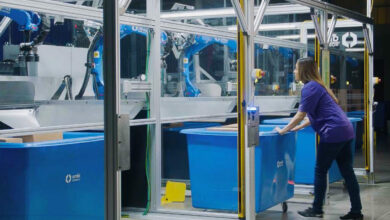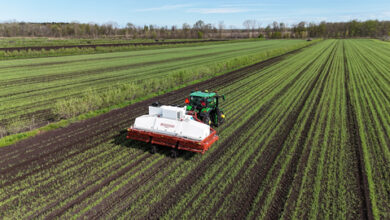Five Things to Consider Before Adopting Robotics for Warehouse Automation

Summary
Modern retailers have an incredible opportunity to futureproof their warehouse operations today, with the goal of increasing efficiency to meet this surging consumer demand.
Revenue related to e-commerce will grow nearly 10% YoY between now and 2029, at which point global revenue for e-commerce alone will reach nearly $5 billion yearly. As a frame of reference, that’s more than double the e-commerce sales numbers from 2020.
Modern retailers have an incredible opportunity to futureproof their warehouse operations today, with the goal of increasing efficiency to meet this surging consumer demand. However, if they don’t take action, these same retailers risk labor shortages, increasing labor costs and ultimately falling behind in meeting customer expectations, which will lead to massive losses in market opportunities for their more adept competitors.
As they stare down the challenge of growing demand and extended labor shortages, I urge warehouse managers to educate themselves on the benefits of efficient solutions like automation and robotics.
The future of warehouse operations will be automated
The pandemic and modern consumer behaviors have exposed deep cracks in traditional warehouse operations. E-commerce demand is increasing with no indication of stoppage. Expectations surrounding “always-on” availability for retail distribution have led many warehouses to improve their efficiency to keep pace with demand. For example, over one-fourth of customers have abandoned their carts because they weren’t offered free two-day shipping. Satisfying consumers’ appetite for fast, free shipping requires a well-oiled logistics operation.
Simultaneously, most retailers face a massive barrier to success: labor shortages. In 2023, nearly eight in ten industrial business leaders cited notable labor shortages as a recurrent issue in their facilities.
Robotic automation has become a powerful method to alleviate the pressing issues of decreasing labor and increasing demand. In fact, many retailers already involve AI-powered and 3D vision-enabled robots in their packing and shipping processes. Automation of this caliber increases outcomes like delivery timelines because robots can safely work 24/7, meeting new consumer demand night and day. Furthermore, retailers who adopt the right robotics model will seldom need to service their robotic co-workers outside of routine maintenance.
Before adopting warehouse automation…
The right robotics solution will differ from operation to operation. Furthermore, certain warehouses will attain ROI from automation faster than others. Leaders evaluating automation and robotics in their warehouse should consider the following.
1. Your workflow is unique. Automation should acknowledge that fact, not ignore it.
Historically, warehouses have been structured around bipedal, two-armed human workers. These workflows don’t always benefit AI-powered robots, which come in various sizes and configurations. Thus, most warehouses must be optimized to compensate for new robotic workflows.
Robotic solution providers can walk you through a workflow audit process to ensure optimal robot deployment efficiency. During this process, you’ll identify the areas and processes where automation can bring value. You may also determine that certain older warehouses won’t benefit from automation without additional investment, whereas newer spaces may be perfect for employing robotic co-workers.
2. Long-term ROI should outweigh short-term investments.
Sticker shock shouldn’t be a reason to delay necessary investments into warehouse automation. If you’re grappling with the cost of robotics deployment, consider more scalable models like robotics as a service (RaaS), which enable warehouses to deploy robots without owning the steep cost of regular maintenance.
Additionally, if you’re experiencing friction when attempting to garner buy-in, consider contextualizing the long-term ROI of automation. This includes labor savings, increased productivity and reduced error rates. Companies have reduced their fulfillment costs by up to 50% after introducing warehouse automation.
3. Certain robots can deploy on day 1—but only with the right provider.
Some robotics providers enable warehouses to realize ROI on day 1—however, only if (1) your warehouse is outfitted for automation and (2) software integration is seamless. I advise seeking providers that integrate within existing warehouse management systems (WMS) and/or existing warehouse control systems (WCS).
4. Not all warehouses will benefit from automation today, and that’s OK.
Because generalized AI on the warehouse floor remains highly conceptual, practical AI-powered robots are purpose-built for specific tasks. The most common examples in logistics are induction, order picking and de-palletization robots. Albeit generally dextrous and capable, these robots will likely perform better on certain items and tasks than others. For example, operations dealing in incredibly delicate, highly variable or temperature-controlled items may not benefit from a modern robotic automation system.
However, robotics providers are making strides in this arena by providing expanded gripper strength and analysis capabilities. I advise that leaders in more specialized industries keep their eyes on these emerging technologies.
5. Humans will never become obsolete in warehouse operations.
AI robots on the factory floor will change manufacturing labor models, but only in that extended labor shortages will no longer prohibit factories from hitting their revenue goals. Additionally, current employees must learn new skills to adapt to AI robotics workflows.
AI-empowered robots are generally autonomous but not infallible. Imagine an unexpected but common induction mishap—for example, a package ripping open on a conveyor belt. Warehouse robots have been trained on how to react in this situation, but different environmental contexts can complicate otherwise simple decisions. Humans become critical during these events. Remote factory workers with access to a robot’s live feed can pinpoint the item or situation and provide context enabling the robot to make the most advantageous decision. In some instances, that might mean advising the robot to remove and discard the affected item; in other situations, to replace it.
By owning high-level decisions like this, humans help factory operations to remain smooth and incredibly efficient.
Assessing next steps
As e-commerce demand and expectations continue to fluctuate, retailers and warehouse operators must embrace automation and AI-based solutions. However, they must also acknowledge that automation is never a one-size-fits-all solution.
By carefully considering factors such as workflow analysis, long-term ROI, software integration and the suitability of specific robotic solutions, retailers can make informed decisions and drive critical efficiencies on the warehouse floor.
About The Author
 With more than 30 years in the robotics and automation industries, Crystal Parrott, COO of Plus One Robotics, has a history of bringing emerging technologies to market. Previously, Crystal served as the Vice President of the Robotics Center of Excellence for Dematic Corp, where she led all robotic initiatives and guided and supported the generation of robotic solution sales in the logistic market. Prior to joining Dematic in 2018, Crystal spent 11 years leading the development of advanced robotics technology and promoting it to create new businesses at Southwest Research Institute. Crystal holds a Master of Science in Management of Technology from the University of Texas at San Antonio as well as a Bachelor of Science in Electrical Engineering from Kettering University.
With more than 30 years in the robotics and automation industries, Crystal Parrott, COO of Plus One Robotics, has a history of bringing emerging technologies to market. Previously, Crystal served as the Vice President of the Robotics Center of Excellence for Dematic Corp, where she led all robotic initiatives and guided and supported the generation of robotic solution sales in the logistic market. Prior to joining Dematic in 2018, Crystal spent 11 years leading the development of advanced robotics technology and promoting it to create new businesses at Southwest Research Institute. Crystal holds a Master of Science in Management of Technology from the University of Texas at San Antonio as well as a Bachelor of Science in Electrical Engineering from Kettering University.
Did you enjoy this great article?
Check out our free e-newsletters to read more great articles..



